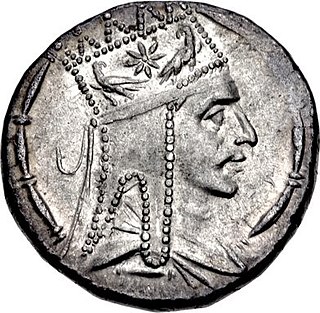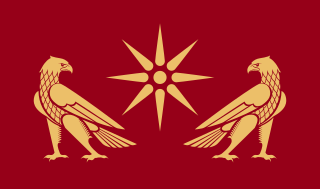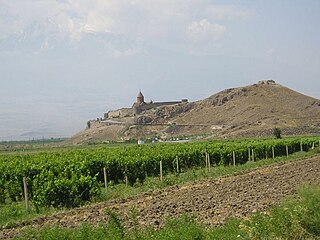Tigranakert or Dikranagerd may refer to Armenian cities founded by Tigranes the Great in 1st century B.C.:
Year 189 BC was a year of the pre-Julian Roman calendar. At the time it was known as the Year of the Consulship of Nobilior and Vulso. The denomination 189 BC for this year has been used since the early medieval period, when the Anno Domini calendar era became the prevalent method in Europe for naming years.

Nagorno-Karabakh is a landlocked region in the South Caucasus, within the mountainous range of Karabakh, lying between Lower Karabakh and Syunik, and covering the southeastern range of the Lesser Caucasus mountains. The region is mostly mountainous and forested.

Tigranes II, more commonly known as Tigranes the Great was King of Armenia under whom the country became, for a short time, the strongest state to Rome's east. He was a member of the Artaxiad Royal House. Under his reign, the Armenian kingdom expanded beyond its traditional boundaries, allowing Tigranes to claim the title Great King, and involving Armenia in many battles against opponents such as the Parthian and Seleucid empires, and the Roman Republic.
Articles related to Armenia include:

Artsakh was the tenth province (nahang) of the Kingdom of Armenia from 189 BC until 387 AD and afterwards made part of the Caucasian Albanian satrapy of Sasanid Persia from 387 to the 7th century following the Peace of Acilisene. From the 7th to 9th centuries, it fell under Arab control. In 821, it formed the Armenian principality of Khachen and around the year 1000 was proclaimed the Kingdom of Artsakh, one of the last medieval eastern Armenian kingdoms and principalities to maintain its autonomy following the Turkic invasions of the 11th to 14th centuries.

The Kingdom of Armenia, also the Kingdom of Greater Armenia, or simply Greater Armenia, sometimes referred to as the Armenian Empire, was a monarchy in the Ancient Near East which existed from 321 BC to 428 AD. Its history is divided into successive reigns by three royal dynasties: Orontid, Artaxiad and Arsacid (52–428).

Artsakh, officially the Republic of Artsakh, formerly the Nagorno-Karabakh Republic, is a breakaway state in the South Caucasus supported by Armenia, whose territory is internationally recognised as part of Azerbaijan. Artsakh controls a part of the former Nagorno-Karabakh Autonomous Oblast, including the capital of Stepanakert. It is an enclave within Azerbaijan. Its only overland access route to Armenia is via the 5 km (3.1 mi) wide Lachin corridor which is under the control of Russian peacekeepers.

Tigranocerta, also called Cholimma or Chlomaron in antiquity, was a city and the capital of the Armenian Kingdom between 77 and 69 BCE. It bore the name of Tigranes the Great, who founded the city in the first century BC. There is so far no common agreement on the precise location of Tigranakert; it was either near present-day Silvan, Arzan, east of Diyarbakır, Turkey, or in the valley of the Garzan river where is mentioned by T.A Sinclair. It was one of four cities in historic Armenia named Tigranakert. The others were in Nakhichevan, Artsakh and Utik, the 4 cities being in the old Armenian provinces Aldznik, Goghtn, Utik, Artsakh.

The Battle of Tigranocerta was fought on 6 October 69 BC between the forces of the Roman Republic and the army of the Kingdom of Armenia led by King Tigranes the Great. The Roman force, led by Consul Lucius Licinius Lucullus, defeated Tigranes, and as a result, captured Tigranes' capital city of Tigranocerta.
The Battle of Artaxata was fought near the Arsanias River in 68 BC between an army of the Roman Republic and the army of the Kingdom of Armenia. The Romans were led by proconsul Lucius Licinius Lucullus, while the Armenians were led by Tigranes II of Armenia, who was sheltering Mithridates VI of Pontus. The battle was part of the Third Mithridatic War, and was a Roman victory.

The Artaxiad dynasty or Ardaxiad dynasty ruled the Kingdom of Armenia from 189 BC until their overthrow by the Romans in AD 12. Their realm included Greater Armenia, Sophene and intermittently Lesser Armenia and parts of Mesopotamia. Their main enemies were the Romans, the Seleucids and the Parthians, against whom the Armenians had to conduct multiple wars.

Silvan is a city and district in the Diyarbakır Province of Turkey. Its population is 41,451.

Vankasar Church is a 7th-century Armenian church located in Agdam District of Azerbaijan.

Tigranes VI, also known as Tigran VI or by his Roman name Gaius Julius Tigranes was a Herodian Prince and served as a Roman Client King of Armenia in the 1st century.

Martakert Province is a province of the Republic of Artsakh, de jure part of the Republic of Azerbaijan. The population is mainly Armenian. The province has 43 communities of which one is considered urban and 42 are rural.

Tigranakert, also known as Tigranakert-Artsakh, is a ruined Armenian city dating back to the Hellenistic period, located in the Agdam District of what is today Azerbaijan.

Shahbulag Castle is an 18th-century fortress near Aghdam in Azerbaijan built by the Karabakh Khan Panah Ali.
Tigranakert or Tigranavan is one of the four cities established by Tigranes the Great, emperor king of Armenia, carrying his name. The one at Nakhchivan served as a sitting city for Tigranes' sister Tigranouhi.

Artashat ; Hellenized as Artaxata and Artaxiasata, was a large commercial city and the capital of ancient Armenia during the reign of king Artaxias I; the founder of the Artaxiad Dynasty of the ancient Kingdom of Armenia. The name of the city is derived from Iranian languages and means the "joy of Arta". Founded by King Artaxias I in 176 BC, Artaxata served as the capital of the Kingdom of Armenia from 185 BC until 120 AD, and was known as the "Vostan Hayots".
Hamlet Petrosyan is an Armenian historian, archaeologist, and anthropologist.